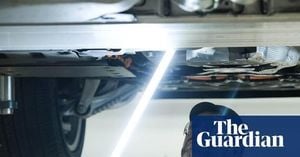A massive fire at Vistra Energy’s lithium battery storage facility in Moss Landing, California, has raised substantial safety concerns following its remarkable four-day duration from January 16 to 19. The fire, characterized by towering flames reaching up to 100 feet, initiated the evacuation of around 1,200 residents, forcing officials to grapple with the potential fallout from this incident. Local authorities reported significant disruptions to the area, including traffic blockages on Highway 1, which is pivotal for tourist access to Big Sur.
Initially reported on January 16, the fire rapidly escalated, showcasing its capacity for destruction and prompting emergency mobilization from local and regional firefighting teams. Smoke billowed across one of the richest agricultural regions of California, raising fears about the environmental impact due to the stored lithium batteries chemical composition. Vistra Energy is currently investigating its fire suppression system's failure, which only intensified concerns over its ability to manage batteries safely.
Alarmingly, scientific evaluations have uncovered the presence of highly toxic metals such as nickel and cobalt within nearby soil samples, collected shortly after the disaster. Such revelations highlight the fire’s potential long-term effects on local agriculture and public health, even though the U.S. Environmental Protection Agency (EPA) has advised there is no immediate danger to residents. Nonetheless, the community and local officials are echoing calls for more thorough assessments and independent investigations to fully understand the extent of the incident's impact.
The incident has also reignited discussions about safety regulations concerning battery storage facilities, especially ones located near communities. Assembly Member Dawn Addis has voiced support for transferring permitting authority from the state to local governments, emphasizing the importance of oversight and adherence to safety measures amid the pressing need for green energy initiatives. Increased demands for scrutiny stem from the broader narrative of California’s ambitious goal of achieving 100% clean electricity by 2045, highlighting the struggle to balance safety with progress.
This incident serves as both a wake-up call and reminder of the vast safety risks inherent within lithium battery technologies, particularly as there have been over 25,000 reported lithium-ion battery fires throughout the United States within the past five years. Highlighting the gravity of the situation, Monterey County declared a state of emergency during the blaze, responding to residents’ growing fears and urgent inquiries.
Local community members, like Heather Griffin, have taken to social media platforms to rally their neighbors, demanding dialogues with officials and raising awareness about the broader issues at stake. Griffin expressed the community's frustration, questioning why such facilities were ever permitted so close to residential areas. The outcry demonstrates the public's need for transparent communication following emergencies, especially with technologies they may not fully understand or trust.
Despite industry experts affirming the safety of newer battery designs, there remains high public apprehension. Local lawmakers, recognizing this tension, have initiated legislation proposing significant setbacks for battery installations, potentially creating 3,200-foot buffers from residences and schools, and prompting heated discussions on energy regulations as states navigate the delicate balance between renewable energy's benefits and community safety.
The pressure is mounting on regulatory bodies to reevaluate and refine safety protocols surrounding battery storage as incidents like the one at Moss Landing highlight potential gaps in existing frameworks. Although the facility was operational since 2020, it lacked compliance with some of the current fire codes and safety measures, indicating the need for the industry to assess both technology development and regulatory compliance continually.
Vistra Energy's history of previous fires at its facilities adds another layer of concern. The investigations to determine the precise cause of the Moss Landing incident will likely influence how regulations evolve moving forward. With greater attention centered around energy safety, the drive to improve fire response strategies and community-focused oversight remains imperative, especially as the demand for renewable energy storage increases.
The fallout from the Moss Landing incident will likely extend beyond the immediate community, shaping public policy, industry standards, and safety regulations across California and potentially the nation. It presents invaluable lessons on how the growing prevalence of energy storage technologies must be harmonized with improved safety practices to prevent risks.
Transitioning to sustainable energy is undeniably important, yet as the grid continues to evolve, ensuring communities feel safe and protected deserves utmost priority. Only then can we charge forward confidently toward our green ambitions, knowing safety precedes progress.



